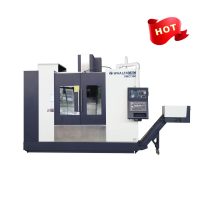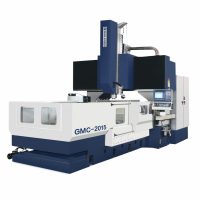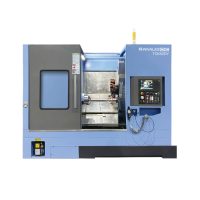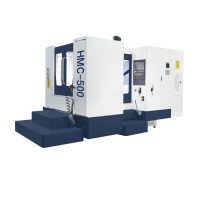E-Mail:sales@whalescnc.com
E-Mail:sales@whalescnc.com
Introduction to Vertical Machining Centers
Key Takeaways
| Aspect | Detail |
|---|---|
| Definition | A Vertical Machining Center (VMC) is a machining center with a vertically oriented spindle. |
| Industrial Impact | VMCs were pivotal in the third industrial revolution, transforming machining processes. |
| Capabilities | Capable of milling, drilling, boring, tapping, and more with high precision. |
| Technological Advancements | Advanced models feature real-time data reporting and high customizability. |
| Applications | Essential in modern manufacturing for a wide range of complex machining operations. |
Understanding Vertical Machining Centers
Vertical Machining Centers (VMCs) have been instrumental in the evolution of machining processes, marking a significant shift in manufacturing capabilities. These centers, characterized by their vertically oriented spindles, are adept at handling a variety of machining operations such as milling, drilling, and tapping, with a focus on precision and efficiency.
The Role in Industrial Evolution
Originating during the transformative third industrial revolution, VMCs played a crucial role in modernizing machining practices. Their introduction revolutionized job shops, allowing for more complex and precise machining tasks. This was a leap from the traditional horizontal machining centers, paving the way for more sophisticated and versatile machining solutions.
Advanced Features and Capabilities
Modern VMCs are not just about performing basic machining tasks; they are equipped with sophisticated technology that enables them to handle complex operations with tight tolerances. The advanced models come with real-time data reporting and are often customizable, making them a valuable asset for any manufacturing setup. For a deeper understanding of the capabilities and benefits of VMCs, explore WhalesCNC’s range of Vertical Machining Centers.
VMCs in Action: Machining Operations
At the heart of VMCs is the ability to perform various vertical machining operations. This includes everything from basic milling and drilling to more intricate processes like boring, tapping, and thread cutting. The vertical orientation of the spindle in VMCs is particularly advantageous for certain types of machining tasks, offering precision and efficiency that are paramount in modern manufacturing.
The Technological Edge of VMCs
- Precision Machining: VMCs are designed to execute operations with extreme accuracy, making them ideal for applications requiring tight tolerances.
- Customization and Flexibility: With options for customization, VMCs can be tailored to meet specific manufacturing needs, enhancing their versatility.
- Real-Time Data Utilization: Advanced VMCs can generate and act upon hundreds of data points in real-time, optimizing machining processes for better outcomes.
For a comprehensive overview of the technological advancements in VMCs, consider exploring Machining Centers offered by WhalesCNC.
Integration with CNC Systems
The effectiveness of a VMC is significantly enhanced when integrated with Computer Numerical Control (CNC) systems. This integration allows for precise control over machining processes, leading to improved accuracy and efficiency. Understanding the CNC Coordinate System is crucial in optimizing these operations.
Enhancing VMC Performance with CNC Tools
- CNC Tool Magazine: The tool magazine is an essential component, ensuring efficient tool management and quick tool changes. Learn more about the CNC Tool Magazine.
- Auto Tool Changer: Automating tool changes reduces downtime and increases productivity. Discover how the Auto Tool Changer revolutionizes tool management.
- CNC Coordinate System: A precise coordinate system is key for achieving accuracy in machining. Delve into the essentials of the CNC Coordinate System.
Versatile Applications of Vertical Machining Centers
Vertical Machining Centers are not confined to a single industry; their versatility makes them a staple in various sectors. From aerospace to automotive, and from medical to energy, VMCs are crucial in producing high-precision components.
Industries Relying on VMCs
- Aerospace: Manufacturing complex, high-precision components.
- Automotive: Crafting intricate parts for vehicles.
- Medical: Creating surgical instruments and medical devices.
- Energy: Producing parts for renewable energy equipment.
To understand how VMCs cater to these diverse industries, explore the detailed use cases on Vertical Machining Centers provided by WhalesCNC.
The Heart of VMCs: Spindles
The spindle is a key component of any machining center, and its importance in VMCs cannot be overstated. It is responsible for holding and rotating the cutting tools, determining the machine’s capability to handle various operations with precision and efficiency.
Understanding Machining Center Spindles
- Spindle Types: Various spindle types are designed to meet different machining needs.
- Speed and Precision: The spindle’s speed and precision directly influence the machining quality.
- Durability and Maintenance: Regular maintenance ensures spindle longevity and consistent performance.
For a deeper dive into the types and features of spindles, visit the detailed guide on Machining Center Spindles.
The Evolution of VMCs: From 3-Axis to 5-Axis
The evolution of VMCs has been marked by the transition from 3-axis to 5-axis machines, broadening the scope of possible machining operations.
The Significance of Axis in VMCs
- 3-Axis CNC Milling Machine: Offers basic X, Y, and Z-axis movement, suitable for a wide range of applications. Explore more at 3 Axis CNC Milling Machine.
- 5-Axis Machines: Provides additional rotational axes, enabling complex geometries and reducing setup time.
Understanding the differences and applications of 3-axis and 5-axis machines is crucial for selecting the right VMC for specific manufacturing needs.
Enhancing VMC Performance with Components
The performance of VMCs can be significantly enhanced by integrating high-quality components. These components not only improve the efficiency of the machining process but also extend the lifespan of the machine.
Essential Components for VMCs
- Tool Holders: Ensure accurate tool alignment and stability during operations.
- Workholding Devices: Secure the workpiece for precise machining.
- Coolant Systems: Improve tool life and surface finish by reducing heat.
For a comprehensive list of components that can boost the performance of your VMC, check out Components for CNC Machining Centers.
Future Trends in Vertical Machining Center Technology
The landscape of Vertical Machining Centers (VMCs) is continuously evolving, driven by advancements in technology and changing industry needs. This evolution is shaping the future of manufacturing, with VMCs at the forefront of innovation.
Innovations Shaping the Future of VMCs
- Automation and Robotics: Integration of robotics for enhanced precision and efficiency.
- AI and Machine Learning: Leveraging AI to improve machining processes and predictive maintenance.
- Sustainable Manufacturing Practices: Adoption of eco-friendly technologies and processes.
Understanding these trends is crucial for manufacturers to stay ahead in a competitive market. For insights into the latest developments in VMC technology, WhalesCNC’s Vertical Machining Centers provide a wealth of information.
The Impact of Automation on VMCs
Automation in VMCs is not just a trend; it’s a transformative force. By integrating automated systems, manufacturers can achieve higher levels of efficiency and precision, leading to increased productivity and reduced operational costs.
Advantages of Automation in VMCs
- Consistency and Quality: Automated processes ensure consistent quality and precision in machining.
- Reduced Downtime: Automation minimizes manual intervention, thereby reducing downtime.
- Enhanced Safety: Reduces the risk of human error and enhances workplace safety.
To delve deeper into the role of automation in VMCs, consider exploring WhalesCNC’s guide on Auto Tool Changer, a key component in automated machining processes.
VMCs and Sustainable Manufacturing
As the world moves towards more sustainable manufacturing practices, VMCs are playing a crucial role. The incorporation of energy-efficient components and processes in VMCs is contributing to this shift, making manufacturing more eco-friendly.
Sustainable Practices in VMCs
- Energy Efficiency: Implementing energy-saving technologies in VMCs.
- Waste Reduction: Precision machining reduces material waste.
- Recycling and Reusing Components: Encouraging the use of recycled materials and components.
To learn how VMCs are contributing to sustainable manufacturing, visit WhalesCNC’s page on Components for CNC Machining Centers, where eco-friendly practices are highlighted.
Conclusion
Vertical Machining Centers have revolutionized the world of manufacturing, offering unparalleled precision, efficiency, and versatility. As technology continues to evolve, so too will the capabilities and applications of VMCs. From their role in various industries to the future trends shaping their evolution, VMCs remain a cornerstone in modern manufacturing processes.
For those looking to further explore the world of VMCs and their impact on manufacturing, WhalesCNC offers a comprehensive range of information and products, making it an invaluable resource for industry professionals.
Need to buy a machine tool?
You can upload drawings of machined parts. Our experts will help you determine the best machine for your needs.
About WhalesCNC
WhalesCNC is a high-quality CNC machine tool manufacturer located in Xuzhou, Jiangsu, China. It has more than 20 years of manufacturing experience and is committed to comprehensive solutions to improve cutting efficiency.




